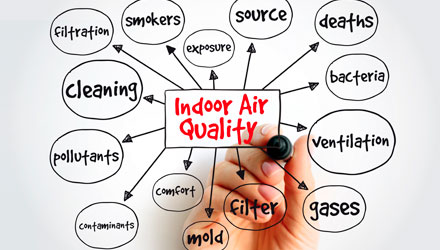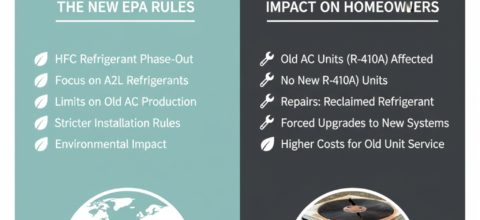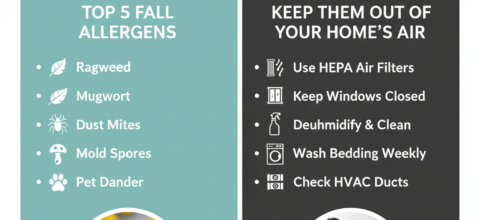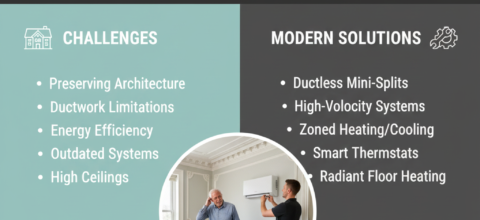Simple Home Maintenance Tips to Improve Your Indoor Air Quality
Indoor air can often feel stagnant, stuffy, or dusty—and for many homeowners, that’s more than just a nuisance. Poor air quality affects everything from respiratory health to sleep and energy levels, especially for families with children, pets, or allergy concerns. The good news is that you don’t need a full HVAC overhaul to improve indoor air quality. With a few consistent home maintenance habits, you can create a noticeably fresher and healthier living space.
What Causes Poor Indoor Air Quality in Most Homes?
Many factors quietly contribute to stale or polluted air indoors. Let’s break down some of the most common sources:
Dust and Dirt Buildup
Over time, dust settles on surfaces, inside ductwork, and deep within carpets. It’s made up of dead skin cells, fabric fibers, pet dander, and outdoor pollutants—all of which can recirculate every time you walk or turn on the heat.
Weak Ventilation
A tightly sealed home keeps energy costs down, but it can trap airborne contaminants. Without consistent airflow, pollutants from everyday activities—like cooking or cleaning—linger much longer.
Moisture and Mold
High humidity creates the perfect breeding ground for mold spores, especially in bathrooms, basements, and around windows. Even minor leaks or condensation can trigger long-term air quality issues if left unchecked.
How to Improve Air Quality in Your Home Naturally
Many homeowners ask: how to improve air quality in the home without fancy equipment? The answer often starts with opening a few windows and making smart lifestyle swaps.
Crack a Window (Yes, Even in Winter)
Allowing fresh air to cycle through your home—even for just a few minutes a day—can significantly dilute indoor pollutants. Focus on high-traffic areas like the kitchen, bathroom, or wherever you spend most of your time.
Bring in Air-Purifying Houseplants
Certain houseplants, such as spider plants, peace lilies, and snake plants, have been shown to absorb toxins like formaldehyde and benzene. They’re a simple and decorative way to support better air.
Ditch Harsh Chemical Cleaners
Many off-the-shelf cleaning sprays release volatile organic compounds (VOCs) into the air. Switch to vinegar-based solutions, castile soap, or unscented cleaners labeled non-toxic to reduce airborne irritants.
Indoor Air Quality Maintenance Tasks Every Homeowner Should Do
A few smart maintenance routines can go a long way toward building long-term, quality home air.
Swap HVAC Filters Regularly
Filters trap dust, pollen, and other particles before they reach your living space—but they only work if changed consistently. Aim to replace standard HVAC filters every 1–3 months depending on system usage and household size.
Schedule Seasonal HVAC Inspections
While changing filters is essential, having your entire system inspected by a professional at least once a year keeps things running cleanly and efficiently. This is also an opportunity to identify airflow issues or hidden leaks early on.
Clean Vents and Registers
Dust buildup around vents isn’t just cosmetic. It restricts airflow and recirculates allergens. Wipe vent covers regularly and use a vacuum hose to pull dust from inside the ducts as far as you can reach.
Can Air Duct Cleaning Improve Indoor Air Quality?
Yes—especially in older homes or spaces with heavy dust, pet hair, or renovation debris. Professional cleaning removes built-up contaminants inside your ductwork that everyday vacuuming can’t reach. When ducts are clogged, even clean filters can’t stop pollutants from circulating.
If you’ve recently moved into a new home, noticed persistent dust on surfaces, or experienced allergy flare-ups, scheduling house duct cleaning might be a helpful step in refreshing your home’s air.
For homes dealing with musty smells or recurring allergens, duct sanitizing after cleaning may offer added peace of mind. Learn more in our blog on air duct sanitizing and indoor air quality.
Other Simple Ways to Reduce Air Pollution at Home
If you’re looking for more ways to cut down on indoor pollutants, consider these easy additions to your routine:
- Run your range hood when cooking: This removes smoke and airborne grease particles before they spread through the home.
- Use a dehumidifier in damp areas: Reducing humidity levels can help prevent mold and dust mites from thriving.
- Shoes off at the door: This cuts down on outdoor contaminants being tracked through your home—especially important if you have carpets.
- Invest in an air quality test kit: If you want concrete data, an at-home air quality test can help identify specific pollutants or moisture issues.
- Consider UV Light Installation: UV lights inside your HVAC system can help reduce bacteria, mold, and viruses—especially in homes with allergies or weakened immunity, where filters alone may fall short.
Final Thoughts: A Healthier Home Starts with Small Changes
Improving indoor air quality doesn’t require a major renovation or expensive equipment. In many cases, the most meaningful results come from simple, consistent actions like changing filters regularly, using low-toxicity cleaning products, and staying on top of moisture and dust control.
For those looking to take it a step further, professional cleaning or UV lights can make a real difference. But even simple habits, when done consistently, can lead to noticeable differences in how your home feels and breathes.
Whether it’s opening windows more often, testing humidity levels, or wiping down vents, small efforts really do add up. Cleaner air at home starts with awareness—and a few smart routines you can build into your everyday life.










